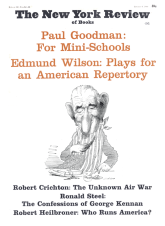In response to:
The Yellow Peril from the December 7, 1967 issue
To the Editors:
I’ve just read “The Yellow Peril” by Michael Field [NYR, Dec. 7], who, having recently written a book on left-overs, suddenly discovers himself to be an expert on Chinese cooking.
I can only suggest to Mr. Field, who seems to be in some kind of pain, that he immerse his typewriter immediately in boiling water. There are many types of virulence in this world and “boiling the water first” is one of the best ways to disinfect anything.
About my own book, The Thousand Recipe Chinese Cookbook, Mr. Field’s opinions put him pretty much in total isolation. Of the fifty or so reviews since publication, all but his own have been unqualified cheers.
What’s more, The Thousand Recipe Chinese Cookbook was voted the best cookbook published last year and thereby honored with the R.T. French Taste-maker Award. Involved in giving this award were more than a hundred food professionals from all over the country, including food writers for newspapers and magazines, cookbook writers, editors, and publishers.
Now, if Mr. Field can bring that water to a boil….
Gloria Bley Miller
New York City
Michael Field replies:
Mrs. Miller’s reply to my review of her book, The Thousand Recipe Chinese Cookbook, is almost as disappointing as the book itself. It seems to me she might have responded in a more dispassionate and meaningful manner to at least a few of the serious objections I raised:
1) the use of arbitrary and archaic culinary procedures such as the one requiring the reader to boil, then cool water before using it to prepare mustard sauce; 2) the shallow essay on rice (one of the most important elements in the Chinese cuisine) and the imprecise and confusing recipes given for cooking it; 3) the repetitious variants (and often sub-variants) on basic Chinese dishes presented as individual recipes to justify the grandiose title of the book; 4) the frequency with which many recipes, strikingly similar to those in other Chinese cookbooks, appear in The Thousand Recipe Chinese Cookbook without acknowledgment of their origins.
As for the “fifty or so” critical “cheers,” Mrs. Miller refers to with pride, I have read them and they are indeed “unqualified” in more ways than one. Generally, they consist of enthusiastic comments about the size of her book (one newspaper even mentions its weight—“exactly 4 1/2 pounds”); admiration for the book’s charming drawings by Earl Thollander; and accolades for Mrs. Miller’s prodigious research. Many of the reviews quote complete recipes from the book, but in none is there a critical discussion in significant depth of the recipes themselves. In the dim light of this, the French mustard company’s Tastemaker Award, however laudable its aims, leads me to wonder how many of the “100 food professionals” who voted for Mrs. Miller’s book actually read all of its 926 pages, tested its important recipes, and compared them to other Chinese cookbooks, before making their fateful decision.
This Issue
January 4, 1968



